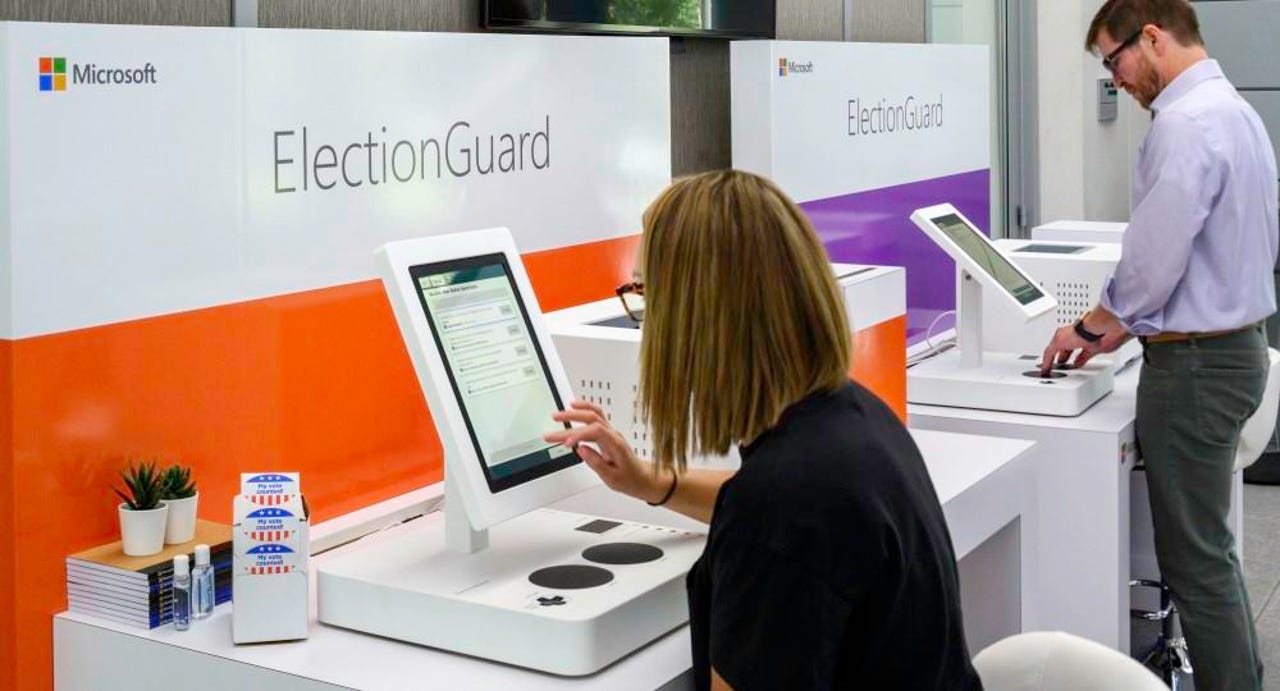Microsoft to deploy ElectionGuard voting software in first real-world test


Microsoft ElectionGuard demos on July 17, 2019 at the Aspen Security Forum in Aspen, Colorado.
Tomorrow, on February 18, residents of Fulton, Wisconsin will elect representatives for the Wisconsin Supreme Court via voting machines that will be running Microsoft's ElectionGuard software.
These will be the first voting machines deployed in any US election that will be running Microsoft's new voting software, which will face it's first real-world test since being announced last year.
From idea to election pilot in just nine months
ElectionGuard is a software development kit (SDK) that Microsoft made available for free on GitHub.
The project's goal was to create the voting software that uses strong encryption, was built by some of the world's brightest cryptographers, and was extensively audited for bugs.
Microsoft created ElectionGuard after numerous media reports over the past years about critical vulnerabilities being discovered in the (closed-source) software of multiple voting machine vendors.
The OS maker purposely released ElectionGuard as open-source in an attempt to convince voting machine vendors to adopt it instead of their older obsolete and insecure systems.
The project, which is viewed with optimism by US election officials, moved lightning-fast, going from a simple idea to an actual US election pilot program in only nine months.
Microsoft announced ElectionGuard in May 2019, demoed a first voting machine in front of a small audience at the Aspen Security Forum in July, released the first ElectionGuard code on GitHub in September, and opened a bug bounty program in October.
Tomorrow's tests will only handle a few hundred votes
The ElectionGuard machines deployed tomorrow in Fulton will only handle a few hundred votes, but this will provide many voting machine vendors and US election officials with a solid test
if the software is worth a shot and if it's ready for wider deployment.
Using ElectionGuard tomorrow won't be complicated, as Microsoft designed the software from the ground up around ease of use, accessibility, and a user-friendly interface.
"Tomorrow's voting experience includes a three-step process," said Tom Burt, Vice President for Customer Security & Trust at Microsoft.
"First, a voter will select candidates on a touchscreen and verify their choices. Second, the voter will print and review for accuracy a paper ballot and simultaneously receive a separate tracking code. Third, the voter will deposit their ballot into a ballot box for counting."
All in all, the technology behind ElectionGuard is relatively simple and centers around a few core principles:
- People who vote receive a tracking code.
- They can use the tracking code on an election website to verify that their vote has been counted and that the vote has not been altered.
- The tracking code does not reveal the vote, so it won't allow third-parties to see who voted for who.
- ElectionGuard uses a so-called homomorphic encryption scheme developed in-house at Microsoft under Senior Cryptographer Josh Benaloh.
- Homomorphic encryption allows the counting of votes while keeping the votes encrypted.
- The ElectionGuard SDK also supports third-party "verifier" apps to independently check if encrypted votes have been counted properly and not altered.
- Verifier apps were created for voting officials, the media, or any third party interested in the voting process.
- ElectionGuard machines can also produce paper ballots, as a printed record of their vote, which voters can place inside voting boxes, like old-fashioned votes.
- ElectionGuard also supports voting through accessibility hardware, such as Microsoft Surface or the Xbox Adaptive Controller.
The voting machines being deployed tomorrow in Fulton were built by VotingWorks.
Other voting machine vendors like Smartmatic and Clear Ballot also announced partnerships with Microsoft to build ElectionGuard-based voting machines last year. A third, Dominion Voting Systems, said it was also exploring using the SDK.
Both Microsoft and VotingWorks will have technical staff on site tomorrow in Fulton, but the companies don't expect any issues.
"We anticipate many more pilots of ElectionGuard technology as we get it ready for prime time," Burt said.